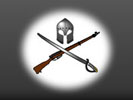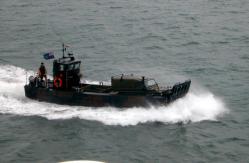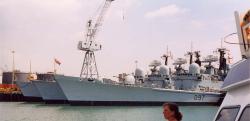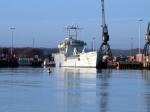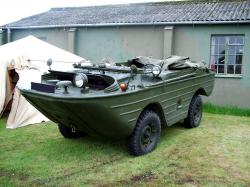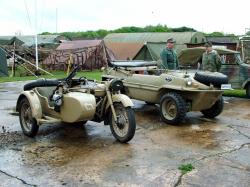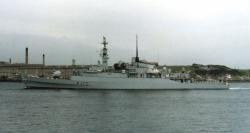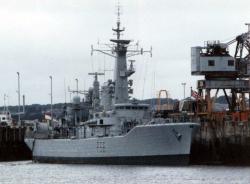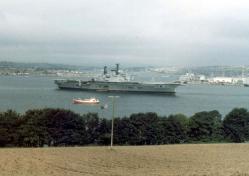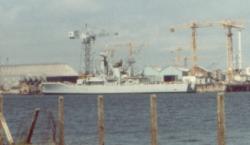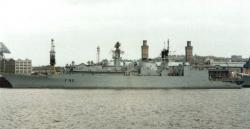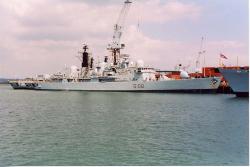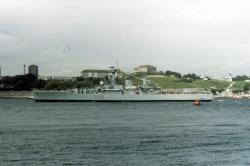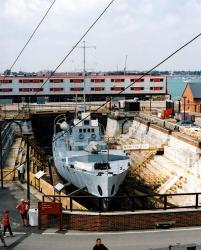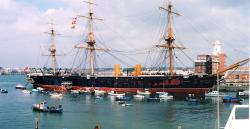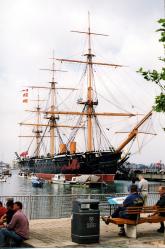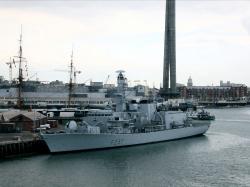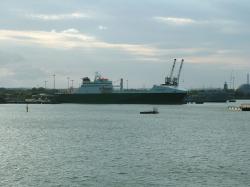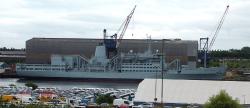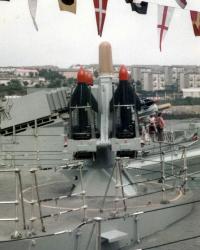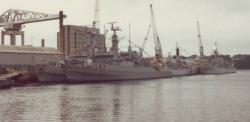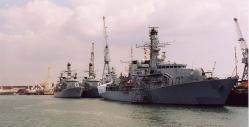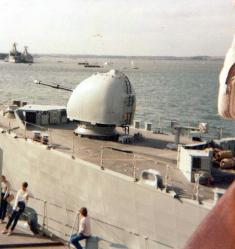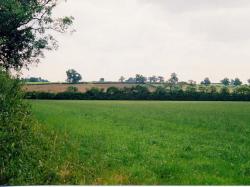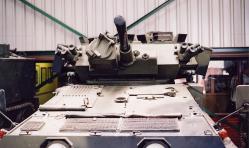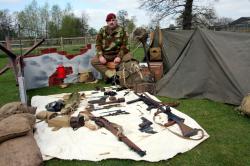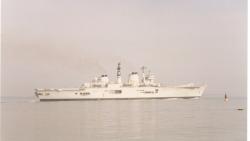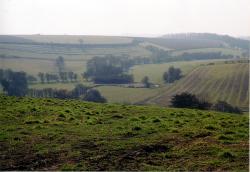Translate this Page
Recent images :
- International Harvester M5 halftrack
- Dassault Mystère Mk IVa number 146
- Ark Royal, Anti-ship missile defence gun.
- RAF Series 2 Land Rover
- Lightweight, air portable Land Rover
- Daimler Ferret Mk 1/2 Armoured Car
- RAF Mountain Rescue Series 3 Land Rover
- French Bronze 6 pounder cannon
- Farsley South African War Memorial
- Farsley War memorial
Images of ships and amphibious vehicles since the 1860
Click on the entry for a larger image and details, or click to go back to the previous index
This LCVP (Landing Craft Vehicle Personnel), from 17 Royal Logistics Corps Port and Maritime Regiment can transport a platoon of Soldiers or, as in this case, a Landrover and trailer and deliver them to a landing beach via the bow ramp.
Portsmouth Naval Dockyard, July 2003
British Type 42 destroyers, HMS Edinburgh (foreground), York & Manchester.
Portsmouth harbour, August 2002.
Round Table class Landing Ship Logistics and Falklands War veterans. In June 1982, the Sir Tristram and Sir Galahad were damaged off Fitzroy, with the loss of 48 Welsh Guards and crew on Galahad. Sir Tristram was towed back to the UK and refitted, Si...
Southampton Water, England. 2006
The GAZ 46 was inspired by US amphibious vehicles supplied to Russia during the War, but entered service in the 1950's an has been used by many easter-bloc allied forces since. It could carry up to 5 people, and due to it's steeply raked front and re...
The Wheels and Wings 2006 event, Yorkshire Air Museum, York, UK. May 2006.
A pair of vehicles maintained by the 21st Panzer Division re-enactment group. The first is a representation of a KS750 Zundapp Motorbike and side car mounting an MG 34 light machine gun in the sidecar. Zundapp produced around 18,000 of these agile, p...
The Wheels and Wings 2006 event, Yorkshire Air Museum, York, UK. May 2006.
An Amazon Class [Type 21] Frigate sunk in the Falklands Campaign. Built. 1975 by Vosper Thornycroft to a commercial design and subsequently bought by the Royal Navy. Displacement. 3250 tons Dimensions. 117m x 13m x 6m. Speed. 34 knots Complement. 1...
Photographed Plymouth 1980.
A Leander class [Exocet conversion] Frigate Built 1967 by Hawthorn Leslie. Displacement 2,860tons Dimensions 113m x 12m x 5m. Speed 27 knots. Complement 230.
Armament 4 Exocet missiles, 3 Sea Cat Missile systems, 2 x 40 mm guns, 6 torpedo tubes, 1 ...
location and date unknown
One of Great Britain's last big carriers, the previous Ark Royal was laid down in May 1943, launched May 1950 but was not completed until 1956 to revised/modernised plans. Displacement 45,000 tons, Dimensions 804 feet x 135 feet x 33 feet, Speed 31 k...
Photographed Plymouth 1980.
Leander Class Frigate H.M.S. Bacchante, built in 1969 by Vickers. Disposed of 1983. Armament : Twin 4.5"" guns, 2 x 20 mm, 1 Sea cat missle system, 1 Mark 10 mortar. This vessel was disposed of by the Royal Navay and shortly thereafter commissioned i...
Not known
Type 22 Frigate [Batch 2]. Built 1985 by Yarrow. Displacement 4100tons Dimensions 143m x 15m x 6m. Speed 30 knots. Complement 290.
Armament 4 Exocet missiles, 2 Sea Wolf Missile systems, 2 x 40 mm and 2 x 20mm guns, 6 torpedo tubes, 2 Lynx helicopt...
Location unknown, 1980's
D88, HMS Glasgow (type 42 destroyer) with Victory in the background.
Portsmouth harbour, August 2002.
Name ship of the Leander class of Frigates. Converted to carry Ikara Anti-Submarine Missile System [1973-76] Built 1963 by Harland and Wolf. Displacement 2,860tons Dimensions 113m x 12m x 5m. Speed 29 knots. Complement 240.
Armament Ikara Anti-Su...
Photographed Plymouth 1980.
An example of a World War 1 single gunned gunboat in dry dock.
Portsmouth Historic Dockyard, August 2002
HMS Warrior, the largest, fastest, most powerful warship afloat when she was built in 1860.
Portsmouth Historic Dockyard, August 2002
HMS Warrior, the largest, fastest, most powerful warship afloat when she was built in 1860.
Portsmouth Historic Dockyard, August 2002
The Type 23 Frigate Westminster, moored in Portsmouth during an Assisted Maintenance Period. Her 4.5 inch Mk 8 gun with 2 quad Harpoon missile launchers just aft can clearly be seen.
Portsmouth Naval Dockyard, July 2003
This merchant vessel is one of six strategic sealift Ro-Ro ships contracted by the Ministry of Defence for use by the Royal Navy when required. She is un-armed, displaces 20,000 tons and can make 18 knots.
Marchwood Naval station, Southampton Water, England. August 2004
The Fort Austin, Fleet Stores Vessel served in the Falklands War of 1982 and continues in service with the Royal Fleet Auxiliary.
She displaces 23,384 tons, can make 20 knots and has a complement of 201 crew including 45 Fleet Air Arm as she can pr...
Wallsend, Tyne and Wear, England. June 2004
A close range anti-aircraft missile used by the British Royal Navy. Its guidance was by radio-controlled visual tracking and its propulsion was by solid fuel. It was fitted to Rothesay Class, Leander Class and Amazon Class Frigates, also in County cl...
Location unknown, 1980's
A veteran of the Falklands War, she was commissioned in 1977 and was sold to Pakistan in 1994.
Not known
2 Type 21's shortly after their return from the Falklands War. Note the pennant numbers still painted out
Plymouth Harbour, 1982.
British type 23 'Duke' class frigates Westminster (foreground) with Richmond and Iron Duke astern.
Portsmouth harbour, August 2002.
The ‘standard’ 4.5 inch/114mm gun fitted in Type 42 Destroyers, Batch 3 of Type 22 Frigates and all Type 23 Frigates. Capable of firing a range of ammunition at up to 25 rounds per minute out to a maximum range of 17 miles.
location unknown
